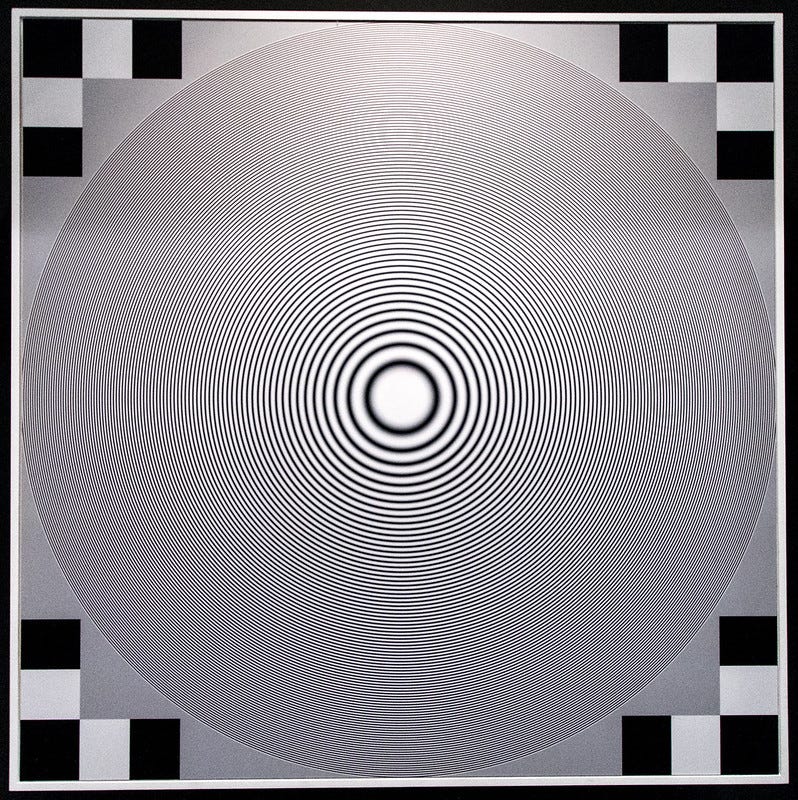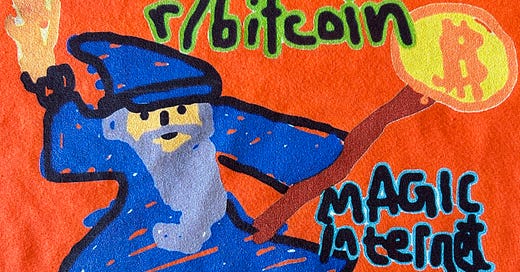Bitcoin, Magic Internet Money Allows Us to Claim Magical Child within
A network backed by relentless optimism now broadcasts a new field of potential. Bitcoiners, now generating happiness from within, begin to direct the flow of currency with the heart’s imagining.
Think about a time when you were a child. How did your experience of life differ from your current grownup experience? The other day, as I was doing spring cleaning, I came across a photo of myself as a small child. I was in kindergarten. I was with my friends and had a big smile on my face as I waved toward the camera. Interestingly, I wore a t-shirt and short pants that were all orange. At the age of four, a sign that I would become a Bitcoiner was already there!
In that old picture of myself, I saw a girl who was radiant, experiencing pure joy. Where had all that joy gone? Thinking about this, I could see that it slowly diminished over time. In my youth, I was still able to maintain a connection with that joyful child. It was when I entered high school during adolescence, that things changed rapidly. It was then that I succumbed to the pressure of societal expectations.
The fiat system measures happiness by external markers of material success: accumulation of wealth, good careers, and high social status. Specifically, the Japanese society that I grew up in is known for its educational credentialism, where one’s prospect of life is determined by academic background, so many parents send their children to cram schools to prepare for the entrance exam.
As if I was being possessed by something, I began the long climb to the top of the educational pyramid. I stopped playing and threw myself into studying to get into a prestigious college. I was so self-disciplined. With tremendous will power, I deprived myself of all the things that would make me smile. I wasn’t really living anymore. I wasn’t enjoying my life. The luminescent child that I once was seemed to have vanished.
We all started life as magical children. The earth was our playground. Free from the burden of society, we were able to fly high with our rich imaginations. Some of you might still remember experiencing that feeling of unlimited potential. Life was easy. It flowed like a river and moved smoothly. Things happened naturally in our favor without us necessarily trying to make them happen. Then, as we got older and became integrated into the fiat system, we slowly began to lose our magic. How does this happen?
Wizard behind consumer economy
To explore this question, we need to look at our current economic system, and the man who played a pivotal role in its shaping. Edward Bernays was a nephew of Sigmund Freud. By applying psychology to business, he distilled and promoted a range of techniques for effective persuasion. Although he originally termed his invention “Propaganda” (publishing a book with that title in 1928), what eventually became known as “Public Relations" revolutionized marketing and made possible the creation of a consumer-driven economy. 1

Like a true magician, imbued with the hidden power of sorcery, Bernays was able to sell anything he offered to the public. Working primarily for Madison Avenue, he helped his big business clients sell their products effectively; convincing women to smoke, and turning bacon and eggs into the all-American breakfast.2 This PR wizard was also able to affect US foreign policies, and manipulate the public in ways which garnered support for war.
What is the source of this magic? Bernays found this tremendous power of influence by studying his uncle Sigmund Freud’s psychological theories of the unconscious (Freud used the term subconscious and unconscious interchangeably at the beginning and later settled with the latter). The founder of psychoanalysis depicted the unconscious mind as a haven for urges, feelings, memories and thoughts that are outside of our conscious awareness. Freud believed the energy contained in this hidden realm provides the primary force that drives our behavior.
The power of subconscious mind
What led Freud to this discovery of unconscious processes was his experience with hypnosis.3 Hypnosis is a method of inducing a trance-like state of deep relaxation. A person in a hypnotic state shifts his or her awareness away from his or her immediate environment. He or she taps into the subconscious mind and becomes absorbed by inner experiences. While still maintaining an awareness of what is happening externally, one becomes open to suggestions that are given either verbally or via imagery.

Hypnotic induction can be used therapeutically, to cure illness, relieve pain and improve one’s life. At times, it has been shown to create an almost magical transformation. But it was not just whispering into an ear that brought about such changes. The magic was created by the startling power of mind to manifest that which is being visualized.
One of the great metaphysical teachers of the 20th century, Neville Goddard articulated about the influence of the internal state on the external reality. He described the subconscious as the “womb of creation” – receiving an idea unto itself and giving it form. The subconscious is like a mind inside the heart that allows us to think freely. This inner mind does not discriminate as to whether some thoughts are negative or positive. It accepts whatever ideas are put into it and begins to engage in active imagination to realize these ideas.
Goddard explains how we can only convey messages to the subconscious through the language of the heart – feeling:
“No idea can be impressed on the subconscious until it is felt, but once felt – be it good, bad or indifferent – it must be expressed…. The subconscious accepts as true that which you feel as true, and because creation is the result of subconscious impressions, you, by your feeling, determine creation”.
So, Goddard tells us. If we want something, instead of just desiring it, we will have to create a feeling as if our wishes have already been fulfilled. Our thought generates electric charges and the feeling that accompanies such thought moves it to create powerful magnetic forces, to attract the reality that we want to come into our life.
Mindless consumption
We all possess this magnificent power of magic. By aligning our thoughts with feelings, each of us can manifest what we truly want. We are whole and complete. We are the source of our own happiness. The knowledge of this power has been kept secret and many of us do not know how to access it.
Yet, all we need to do is to remember that we have this magic wand and start to practice using it. The key is to become mindful of how we feel and constantly generate feelings that would create a reality that we truly wish to manifest. By not mastering this way of thinking with the heart, we might easily give undesirable input to the subconscious and inadvertently become a victim of our own creation.

By taking advantage of our lack of knowledge, big businesses intervene in the process of reality creation. Through marketing and mass communication they began to use this power against our self-interest. Funded by money that can be printed infinitely, advertising agencies generate endless persuasive suggestions to program our subconscious. Messages broadcast through radio, cable TV, and movie theaters tell us that we can be happy only through material success, by becoming someone or somebody with lots of things!
Many of us have been tricked into thinking that we are not adequate in ourselves, and that we need to look for things outside of us to make us joyful. From designer clothes and sports cars to fancy makeup, products are being sold with the promise that they will magically enhance us.
Being mesmerized by the fabricated images of products that are made to look appealing, we begin to engage in mindless consumption. To become more sexy, attractive and powerful, people chase after consumer goods and seek to gain fame and recognition. As we are hooked into a market that incessantly demands our attention, we are being pulled out of our heart. Instead of being in a state of happiness, we are brought down to the abyss of darkness, permeated by a constant feeling of lack and by perpetual desire.
Breaking the spell
Bitcoin, a magic internet of money, has now begun to break the hypnotic spell. In the emergence of Bitcoin, I saw a light shining out from the bottomless pit of our hyper-consumerist society. Following this tiny light I fell down the Bitcoin rabbit hole. As I traveled down this path, the light became more brilliant, illuminating the girl with sparkling eyes captured in the snapshot of my childhood photo. There, I found myself, a pure being of light, waiting to be remembered.
I wasn’t the only one treading on the road to self-recovery. My personal journey intersected with others who also found their way into the rabbit hole and were slowly awakening. One by one, those who found Bitcoin started to withdraw themselves from rampant consumerism.
Holger von Krosigk, a writer who specializes in the philosophy of Bitcoin, observed this trend of Bitcoiner’s non-participation in the consumer economy. In the piece titled “Bitcoin Is the Rebirth of Saving Culture” published on his site (dematerialized.blog), he notes the fierce refusal of Bitcoiners to engage in excessive spending, and ways in which this has generated almost ‘cultish behavior’ among them.
He explains how, with expressions such as Stacking Sats”, Hodl”, or “BTFD” (“buy the fucking dip”), Bitcoiners refrain from spending, and tend to have a frugal lifestyle. The author points out that, historically, saving was recognized as vital economic activity, allowing us to build up capital. He describes how – from Protestants who practiced deferred gratification, to banks as far back as the High Middle Ages rewarding savers – people across cultures, and in different times, recognized the value of saving and supported it.
The article brings attention to the fact that there was even a cultural movement to promote saving, such as creation of the World Saving Day on October 31, 1924 (a global advertising campaign for the savings account, which engaged more than 300 savings bank representatives from 28 countries). Von Krosigk notes how, overtime, this movement has been winding down, but now it is being revived through the invention of Bitcoin. He points out the interesting coincidence of Satoshi’s Bitcoin whitepaper being released, not just on Reformation Day, but also on World Savings Day 2008.
Claiming the power of imagination
This incentive for saving is coded in Bitcoin. It is one of the unique features of this technology. With its fixed monetary supply, Bitcoin is a currency of a new asset class. Its design of built-in scarcity, with issuance that decreases every four years, is guaranteed to increase its value (with a math cap on its money base to prevent it from ever being popped like a fiat bubble).
With an increase in our purchasing power, Bitcoin lowers time preference (incentivizing us to think long-term and forgo instant gratification). Individuals, by aligning with this protocol’s new incentive, can now shift internally and gain direct access to the unlimited power of creation that is stored in our heart.

Through the practice of Hodling (holding Bitcoin regardless of its price and disengaging in speculation), Bitcoiners overcome temptation that makes them buy things that they don’t need. Through our collective engagement, a network becomes stronger. It creates resistance that can help us hodl the child within who knows how to play, how to create magic.
Changes are happening. People are beginning to claim their power of imagination. In the Bitcoin space, new services are popping up to assist this process of grand transformation.4 Those who are orange-pilled, are now linking with one another, building a new social layer.
A network backed by our shared feeling of relentless optimism now broadcasts a new field of potential. We have learned to believe that we can fulfill the internal void that can never be filled with material things. Bitcoiners, now generating happiness from within, begin to direct the flow of currency with the heart’s imagining.
With a laser beam eye, we can now select a version of the future that we want. As the Bitcoin price hits an all-time high, the wealth of our creative power now increases. The heart of the network that beats every ten minutes now calls each of us to become the powerful wizard that we are all meant to be.
Acknowledgements:
I would like to thank La Fleur Productions for her proofreading.
Notes
At the end of World War I, US corporations were facing the possible issue of overproduction. They were worried that people who already have enough goods would stop buying. Paul Mazur of Lehman Brothers, back in 1927, expressed this sentiment in the Harvard Business Review:
“We must shift America from a needs, to a desires culture. People must be trained to desire, to want new things even before the old had been entirely consumed. We must shape a new mentality in America. Man’s desires must overshadow his needs.”
Before Bernays spearheaded the creation of the advertisement industry, Americans bought only what they needed to survive. The mastermind behind today’s consumer culture was able to convince people that they won’t feel happy unless they purchase products and services that are being offered.
Hypnotism started in the late 18th century, when Franz Mesmer, a German physician, developed his theory of Animal Magnetism, also known as mesmerism. Mesmer, during his magnetic treatment with his female patient, felt a fluid, something akin to electricity flowing through the woman’s body. This experience led him to become aware of the existence of an invisible natural force possessed by all living beings, including humans, animals and plants. He called this force animal magnetism and applied it to creating a healing system.
Magnetism is produced by the motion of electric charges. It is a force that attracts (pulls closer) or repels (pushes away) objects that have a magnetic material. This mysterious force that enabled him to hypnotize patients has been shown to almost magically cure illness of all kinds. But it was not just this force exerted by magnets that brought healing. Remission from symptoms occurred through the power of mind to influence the body.
Bitcoin Pleb Coach, a company based in Germany, teaches fellow Bitcoiners a tool of self-hypnosis to open the inner mind so as to reclaim their power of imagination. Services that are offered help people release toxic lifestyles, beliefs and conditioning that they inherited from the fiat system.
To find out more about their work, listen to this episode, “Hypnosis Fixes This” on Daniel Prince’s podcast Once Bitten.





A fascinating and fresh perspective on an area I've followed pretty closely over the years ...
Excellent piece of writing, as always. Thank you!